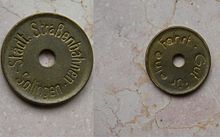Perforated coin
As hole coin in which it is Coin a coin referred to, which has in the middle a hole. The reason for the production of perforated coins is the material savings achieved through the perforation. However, if the hole was later inserted into the coin after the minting, it is called a perforated coin . Coins, for example, are punched afterwards to cancel them or to hang them on a chain.
Germany
In Germany there were never perforated coins as a regular means of payment, however, between 1913 and 1914, the German government in German East Africa issued 5 Heller pieces made of cupronickel with a hole in an edition of 3,000,000. The corresponding 10-Heller piece was minted between 1908 and 1914, had an edition of 3,200,526 pieces and was also made of copper-nickel.
In 1918 in Belgium the German occupying power issued 50 centime pieces made of zinc , which were also perforated coins. The circulation for these pieces was 7,397,000.
The last German perforated coins so far were issued by the Reichskreditkassen between 1940 and 1941 . They were in circulation mainly in the occupied territories in Eastern Europe, but not in Germany itself. These were 5- or 10- pfennig pieces of zinc .
Still in use
Today's hole coins are z. As in Denmark , the 1, 2 and 5 crowns (since 1990/1992), in Norway , the coins of 1 Crown (since 1997) and 5 crowns (since 1998), the Japanese 5- and 50- yen coins, as well as the rare 25 piasters coin from Egypt and the 5 sentimo coin from the Philippines .
No longer in circulation or use
Europe
Examples of perforated coins from European countries are:
- Spain : 25 pesetas (in circulation from 1990 to 2001), the former 50 centimos coin was also a perforated coin.
- Belgium : The Belgian 25 centimes coin was a perforated coin from the First World War until the German occupation in the Second World War . During the German occupation, the coin was made from inferior material, which is why the hole was the weak point of the coin, so the old coins are easily broken in the hand today. The 5 centimes coin minted before the First World War was also a perforated coin.
- Denmark : 25 ore (1924–1948, 1966–1988). From 1924 onwards, all Danish Öre coins were minted with a hole. The punched coins were replaced by punchless coins after the Second World War, in 1967 the holes were only reintroduced for the 25 ore piece.
- Until the German occupation in World War II, France had a 10 centimes hole coin.
- The 2- fillér coin from Hungary (out of circulation for years) was a perforated coin made of aluminum .
- In 1906 Romania issued 2 perforated coins, 5 and 10 bani .
- Greece : from 1954 a 20 Lepta hole coin was put into circulation. There was also a 5-lepta hole coin.
Other countries
- Lebanon : the 0.5 pound hole coin was minted in 1944.
- Laos : the 20-cent coin that France introduced during colonization was used until its own coins were issued in 1952.
- In British East Africa , the 1, 5, and 10 cent coins were perforated coins.
- In India there was a 1-piece coin during World War II that had a particularly large hole.
- Tunisia had a 10-cent hole coin from before the First World War until the currency changeover.
- Before the Second World War, Papua New Guinea had a one-shilling perforated coin and today it has perforated coins again
In China , perforated coins symbolized heaven and earth with their outer round shape and their square center hole. Many Chinese amulets are shaped like punched coins. (See cash ).





